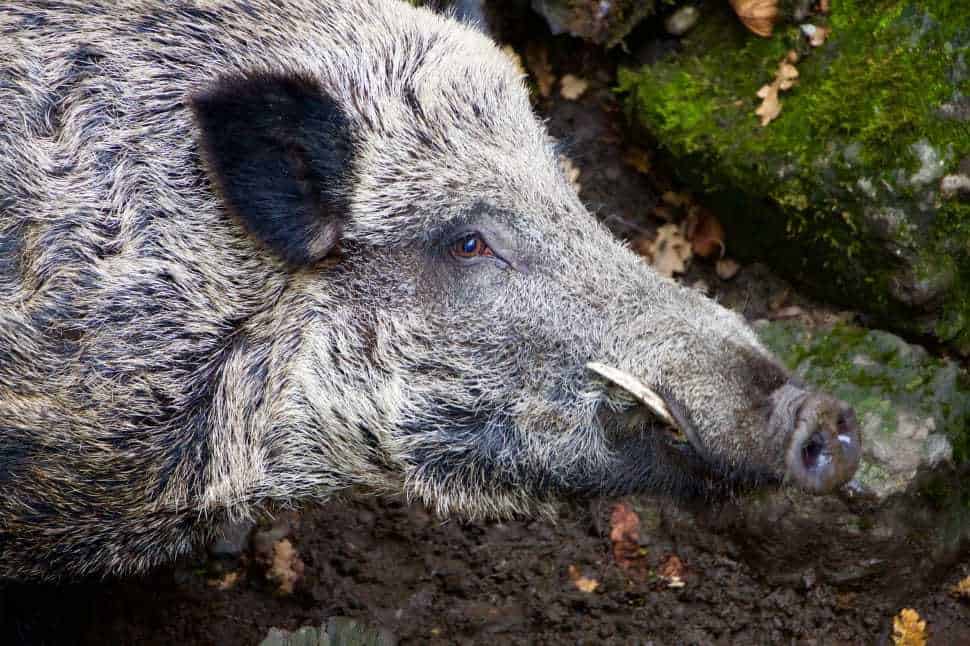Hog hunting is an enjoyable, year-round sport that can be done almost anywhere but is immensely popular in Southern states like Florida, Texas, and Louisiana since they are a major nuisance animal in these places.
But, even though they are a nuisance that does not mean they do not come willingly or they are not difficult to hunt. While hog hunting has traditionally been done mostly at night, daytime hog hunting can be just as fun and you can still have a lot of success with it if you do it right.
To successfully hunt hogs during the day, you need a combination of the right weather, scouting techniques, and patience. Consider hunting watering holes, bedding areas, and using feed as an attractant to increase your chances. Put in a little work ahead of time to exponentially the odds of a successful harvest.
Want to know more?
This guide will answer some of your most common questions regarding hog hunting during the day. By the time we are through, you should be comfortable to strap on your boots and go get some hogs!
What Are Feral Hogs?
Wild hogs, as we know them today, were first introduced in the 1500’s when the Spanish brought them to Florida. Over the past 500 years, hogs have spread to almost every state in the country but they are still mostly concentrated in the South.
During the 1980s, the hog population received its biggest boost in centuries when masses of imported Eurasian boars escaped captivity and made their way throughout the United States.
As far as what to call them, a group of hogs is called a sounder. A female hog is called a sow and males are called boars. They are a medium-sized animal with males weighing in on average between 170 to 220 pounds and females weighing about 130 to 180 pounds.
However, feral hogs often grow well beyond this size with hogs of several hundred pounds being quite common. The world record hog weighed over 1,000 pounds!
What Kind Of Damage Do They Do?
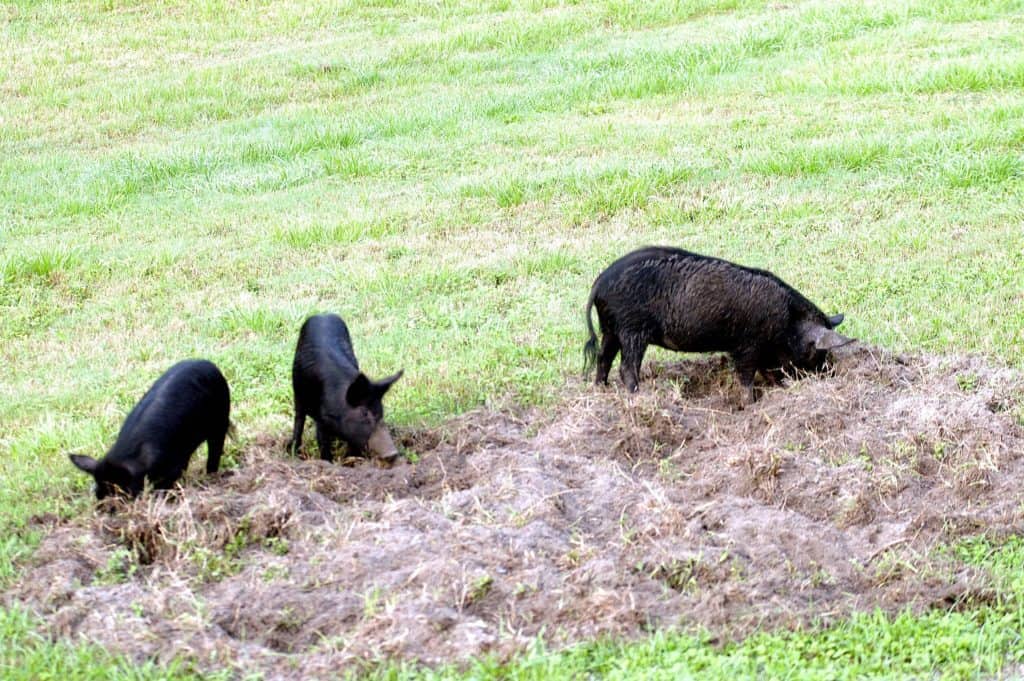
Hogs are by far considered the single biggest cause of property and agricultural damage in the country. Below are examples of some of the damage these animals can do:
Crops
Feral hogs are omnivores meaning they eat both meat and vegetables. They are voracious eaters and find their food by rooting in the ground.
They will eat practically anything to include: corn, grain, soybeans, peanuts, rice, and most other foodstuffs. But, they do not even have to eat the crops to cause damage since their rooting, trampling, and wallowing all crush crops into a useless mess.
Pasture
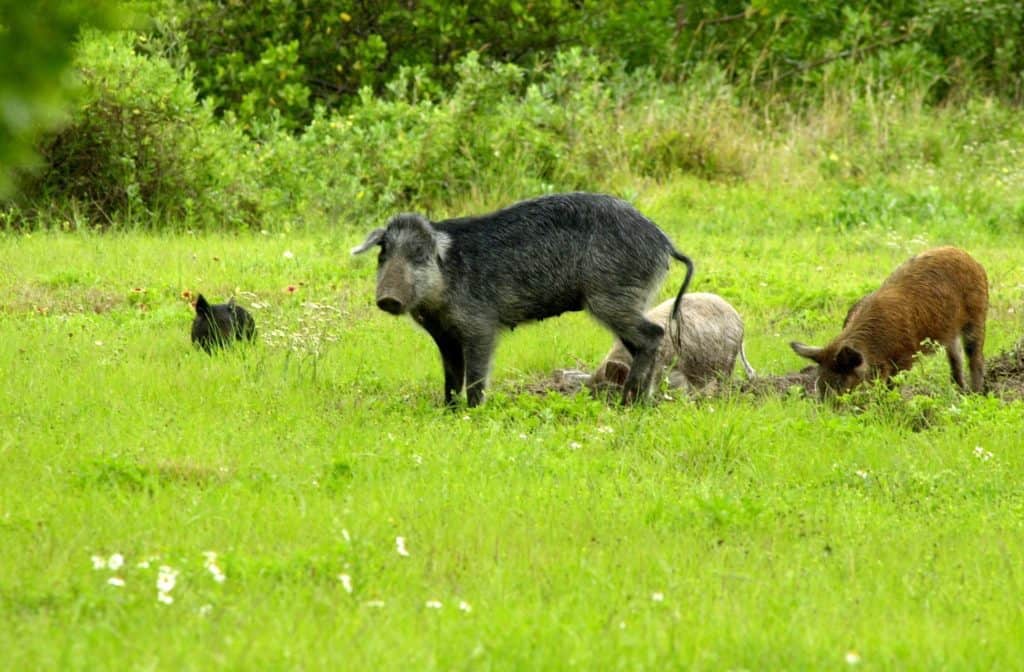
Hogs also damage good pasture land since weeds will often grow to replace the crops eaten by them. They also damage the soil through all their rooting.
All of these ruts can also make it extremely difficult for farmers to drive tractors over their fields to harvest their crops as well.
Livestock
Feral hogs are known to carry up to 40 different diseases that can be transferred to livestock and humans alike. There is also the constant fear of feral hogs transmitting swine flu to a pig population even though this disease was eliminated from the US in 1978.
They also attack vulnerable animals like the young and those that are sick. And if that were not enough, hogs will often contaminate the water and feed of livestock making the resources unusable and infecting those animals with disease.
Horticulture
Crops are not the only plant life hogs can harm. They will target vineyards, orchards, and plant nurseries as well. Not only will they eat the plant life, but will also break irrigation lines and other equipment needed to run the orchard or nursery. They also scrap bark off of trees making them vulnerable to disease.
Property Damage
Those involved in the agricultural industry are not the only ones susceptible to damage from hogs. In their hunt for food, hogs will destroy lawns, gardens, and fences of peoples’ houses.
They also damage public property like beaches, cemeteries, and parks. Lastly, they are a frequent cause of damage to cars when they are involved with collisions.
What Is The Best Time Of Day To Hunt Hogs?
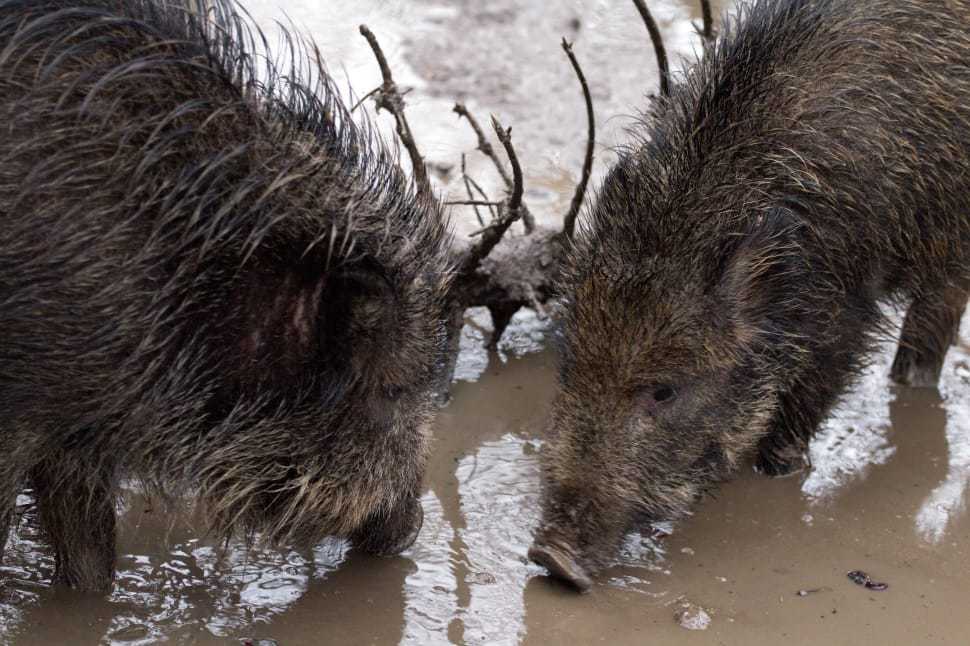
Now that we know a little background on wild hogs, how do go about hunting them?
The best time to hunt hogs during the day would be right after sunrise and right before sunset. This is because hogs normally root for food at night and during these times are making their back to their bedding areas to rest for the day.
But, this is not a hard and fast rule. There are environmental factors that will make them more active all throughout the day.
In very hot weather, hogs are more likely to venture out during the middle of the day when it is hottest to cool off since pigs do not sweat.
Conversely, during very cold weather they are more likely to be rooting during the day since the colder temperatures allow them to move faster and cover more distance. They are more comfortable moving during this time.
Where Are Wild Hogs During The Day?
Normally, hogs will sleep up to 12 hours during the day in nests made of leaves and straw. But when they are not sleeping, they can be found in thick woods with lots of potential for food like berries, roots, and grubs.
They can also be found in open grasslands since here they can find additional food sources. They need to drink water and cool off during the day, so any creek, lake, or body of water is sure to have hogs coming and going to it at various hours of the day.
What Do Wild Hogs Do During The Day?
What hogs do really depends on where they are and how much influence people have on where they live. In areas with little human contact, hogs tend to be diurnal meaning are active during the day and sleep at night. In areas with lots of human contact, this pattern is reversed to avoid it.
The pattern can also be reversed because of the seasons with hogs being less active during the day and more active at night during the summer. The winter, of course, is the opposite.
As far as what they do, if they are not actively rooting for food, they are probably sleeping. If they are too hot, they will go to a body of water to wallow or cool off then return to sleeping.
What Attracts Wild Hogs?
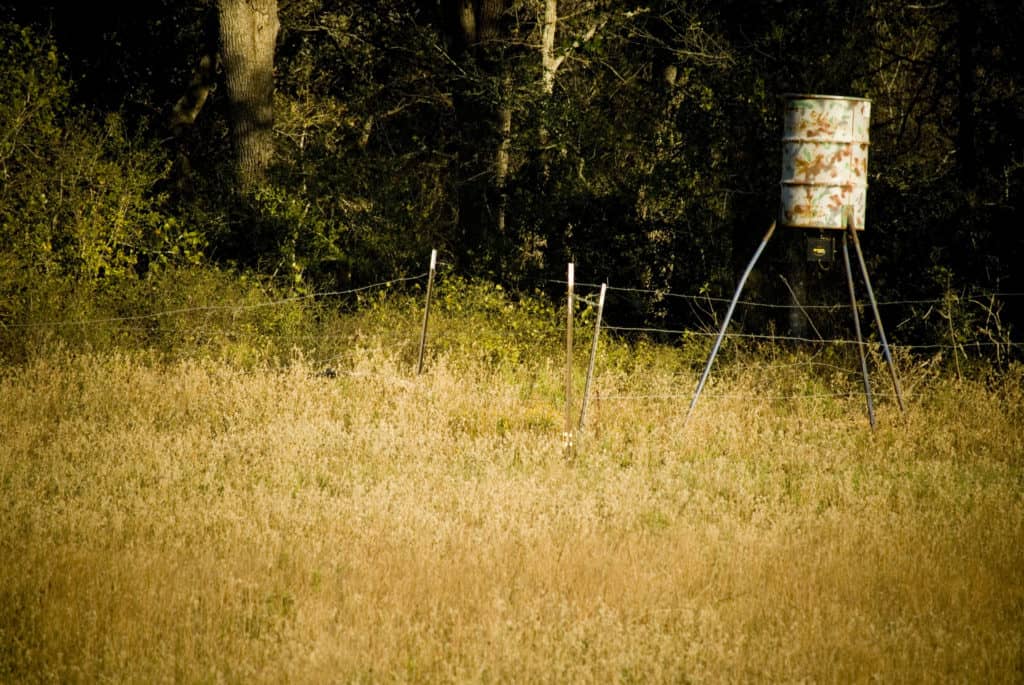
The main thing that attracts hogs is food, specifically corn. Corn is by far the most popular bait used for hog hunting mainly because it is a staple in their diet.
There are various ways to spread the corn around with some people using timed feeders while others use a gunny sack that lets it drip down to the ground.
You can also dig holes in the ground with a post digger and fill it with corn then let the hog’s natural curiosity come to dig them up.
What makes the bait work even better is adding sugar to the corn. Kool-Aid, coffee packets, pancake syrup, and even beer, which has natural sugar in it, can be mixed in with the corn to make it almost irresistible to hogs. This is because hogs need a lot of sugar for energy and they crave it.
There are also various calls on the market today but these have been met with mixed results at best. The most proven method to attract hogs is still baiting most specifically corn but other kinds of bait like sugar cane and soybeans work too.
How Long Does It Take For Hogs To Find Bait?
One of the most common methods of hunting hogs is to use traps. Traps come in various shapes and sizes, but what they all have in common is using bait. But you cannot just throw bait on the ground and start seeing hogs come in the next day. You have to condition them.
When you first start baiting, it might take a week or even up to a month for a hog to find the bait or be comfortable enough to eat it. Over time, as you condition the hogs in your area to the bait, they could come in as little as a day or up to about a week still.
Be careful not to over hunt an area with bait because wild hogs will catch on to this and may be less likely to take the bait in the future.
Can Wild Hogs Smell Humans?
Wild hogs have an incredible sense of smell. Scientific studies have shown their sense of smell is even better than deer! Hogs can even smell humans for several days after leaving an area so using a good scent remover is recommended for any hog hunting.
How Do You Hunt Hogs During The Day?

Hunting hogs during the day presents unique challenges not found at night when hogs usually like to root for food. But do not worry, below are a few good tips and tricks to make your daytime hog hunt just as successful as your nighttime one!
Tracking Hogs During the Day
There are some telltale signs that hogs are nearby. The most obvious one would be tracks. But, another one would be ruts and rises in the ground.
Here are a couple of other signs to look for:
- Ruts and rises in the ground
- Fresh excrements
- Muddied up holes
For ruts and rises in the ground, this would indicate hogs looking for food nearby if they are fresh. Excrement, especially if it is fresh, is another great sign.
Fresh hog excrement should have the consistency of oatmeal. Lastly, muddied holes show that hogs like that spot for wallowing to cool off.
Calls
The best kind of call to use for hogs would be a predator call. Calls like coyotes are great to flush hogs from their hiding spots into the open.
Be mindful to keep a safe distance when using this method since this will frighten the hogs making them more unpredictable and aggressive than they normally are.
Remember, calls have mixed reviews and results, at best.
Using a Feeder
The best way to get hogs out during the day is to use a feeder. As mentioned earlier, there are a variety of feeders than you use or make that really depends on personal preference.
But, to get hogs out at a certain time, a timed feeder is the only option. A timed feeder will dispense a small amount of food at a particular time. Hogs are very smart animals and over time will recognize the sound of this feeder going off means a free meal.
Once you have conditioned hogs in your area with small amounts of bait, and they are comfortable with it, you can then start hunting them during those times!
Stalking Watering Holes
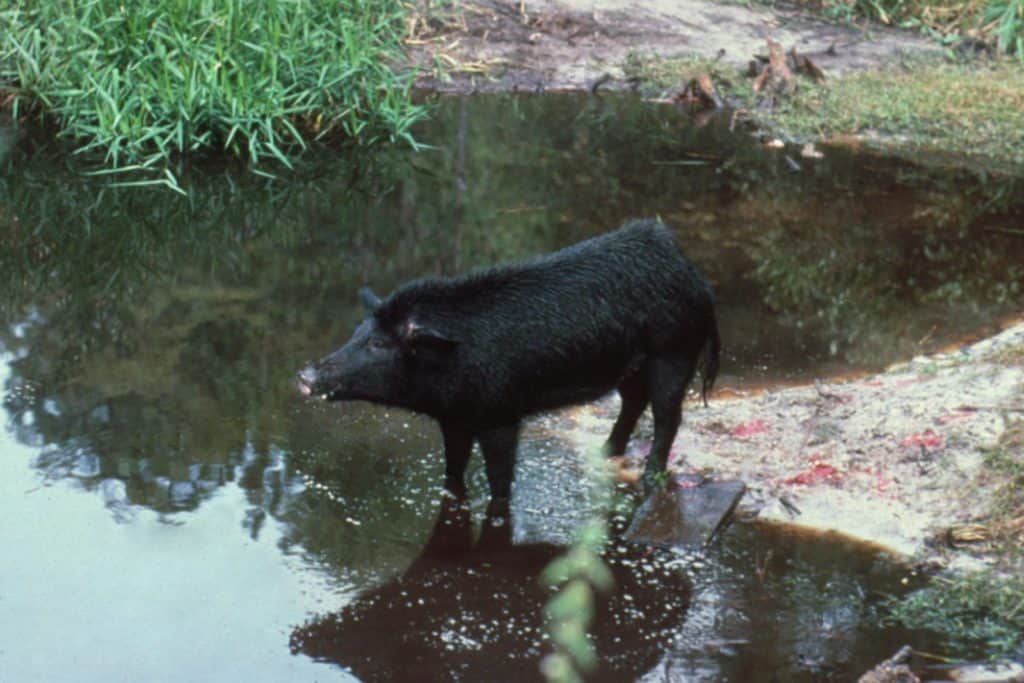
Despite sleeping most of the day, hogs will need to venture out for water and for wallowing, especially when it is hot. It is best to scout your hiding spot days in advance.
This allows you to find one that gives plenty of concealment while also maximizing your coverage and view of the water. It also eliminates the chance that your lingering smell will scare the hogs away.
The best spots are also ones that show active signs of use like wallowing which would be tracks, fresh excrement, and spots where the pigs have rolled around. It is definitely going to be hot but if you are sweating the hogs are going to be too!
Tracking
Tracking during the day is pretty difficult. Listening for sounds of pig squealing is a great way to tell if hogs are nearby. You should also stay downwind of what direction you intend to stalk so as not to alert hogs to your presence.
Exercising good noise discipline will increase your chances of finding a hog during the day so it is best to practice hand signals beforehand to avoid talking if you are hunting with a partner.
A note of caution is to avoid hog shelters during the day when they are sleeping. If stumbled upon here, hogs can become very aggressive and much more dangerous than usual.
Will Hogs Come Back After Shooting At Them?
For as smart as hogs are, one of their main faults is that once they are focused on feeding, they seem to lose all other situational awareness. But, that is bad news for them and good news for you!
Often, especially when hunting with a feeder, hogs will come back after a shot. Sometimes pretty quickly, but it can take up to a few hours.
If you shoot a hog at night, it is best to leave it and wait a while before retrieving it. There have been plenty of times where hogs have had one of their own shot and killed, only to return shortly thereafter to keep eating the feed!
For those that want to hunt hogs with a bow, you are in even better luck since hogs will usually come back right away.
Where Do Hogs Go When It’s Raining?
Believe it or not, hogs are actually much more active when it rains than when it is not! Thinking about it logically only makes sense. Hogs need to expend energy to root up their food and doing so causes them to overheat.
When it rains, the ground is very soft which means they use less energy to get more food and can cover more ground since the rain cools them off.
More food equals larger distances which means they are incredibly active when it rains and can be found in places you might not usually see them.
Conclusion
So there you have it! While there is certainly much more to be said about hog hunting, this should give beginners a good sense of where to start and should debunk the myth that hog hunting can only be done at night.
When using the right methods, you can make the hogs come to you or find them with ease. It just takes a little planning and preparation beforehand.
Now, what are you waiting for? Good strap on your boots, grab some corn, and start hunting some hogs!

